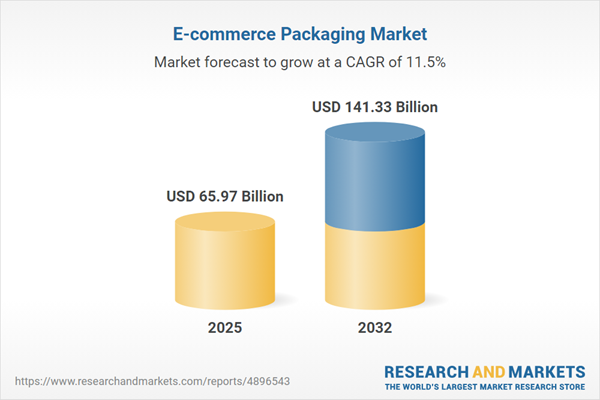Speak directly to the analyst to clarify any post sales queries you may have.
The e-commerce packaging market is rapidly evolving as organizations adapt to increasing regulatory scrutiny, innovation in digital commerce, and the demands of supply chain transformation. Senior executives are prioritizing agile strategies that balance operational resilience and sustainability while capturing emerging opportunities driven by digital growth.
Market Snapshot: E-commerce Packaging Market Size and Growth
The global e-commerce packaging market is forecast to grow from USD 59.15 billion in 2024 to USD 65.97 billion by 2025, at a compound annual growth rate of 11.5 percent. This expansion is fueled by steady increases in digital commerce activities impacting both B2B and consumer sectors. Investment in advanced packaging technologies and fulfillment solutions is reconfiguring supply chain operations and aligning with global compliance requirements. The shift towards flexible and innovative packaging formats is becoming essential for brand differentiation, customer retention, and optimizing efficiency in an increasingly dynamic environment.
Scope & Segmentation: E-commerce Packaging Market Analysis
- Material Types: Corrugated board, glass, metal, paperboard, and plastic film are selected for their ability to support sustainability targets, promote transportation safety, and further circular economy initiatives.
- Packaging Types: Flexible packaging such as bags and pouches enables efficient handling across fulfillment processes, while rigid solutions—including bottles, jars, tubs, and cans—fulfill requirements for durability and product integrity.
- Applications: Industry-specific packages ensure compliance and protect high-value goods across electronics, pharmaceuticals, food and beverage, hardware, and personal care sectors, addressing end-user satisfaction and safety.
- Distribution Channels: The market spans direct-to-consumer approaches, digital marketplaces, proprietary business platforms, and integrated fulfillment networks, facilitating broad market reach and efficient last-mile delivery.
- Regions Covered: The Americas focus on recycling and regulatory alignment, Europe advances circular and reusable materials, Asia-Pacific leads in connected packaging solutions, and the Middle East and Africa concentrate on localized adaptation to regulatory and environmental challenges.
- Technologies and Strategies: Key enhancements include use of lightweight recycled materials, automated sizing, QR codes, omnichannel packaging compatibility, sensor-enabled tracking, and digital print—delivering on traceability, transparency, and consumer engagement.
E-commerce Packaging Market: Key Takeaways for Decision-Makers
- Organizations leveraging customized packaging enable distinct brand positioning while meeting evolving customer expectations in digital channels.
- Adoption of sustainable materials supports compliance initiatives and strengthens corporate environmental strategies with measurable operational benefits.
- New tools such as digital labels and smart features provide greater visibility across the supply chain—enabling timely, responsive decision-making.
- Features like tamper-resistance and temperature monitoring are vital for protecting product quality, especially in industries with sensitive or regulated inventory.
- Localization streamlines regulatory compliance and reduces complexity in cross-border trade execution, easing market entry and minimizing risk.
- Collaboration across logistics and supply chain partners enhances adaptability, supporting reliable operations as fulfillment models shift.
Tariff Impact: Navigating Supply Chain Cost Structures
Recent changes in trade policy, especially those related to US tariffs such as Section 301 and Section 232, are compelling organizations to reassess sourcing strategies and emphasize more resilient procurement models. The resulting shift favors domestic supply chain integration and the consideration of cost-effective substrates like paperboard and corrugated board. By prioritizing flexible sourcing and supply chain resilience, companies are better positioned to maintain operational continuity despite evolving regulatory pressures.
Methodology & Data Sources
This analysis combines secondary research with direct interviews of senior industry executives and targeted regional surveys. Scenario-based risk modeling is used to refine data quality, ensuring robust market planning and actionable insights tailored to executive needs.
Why This Report Matters: E-commerce Packaging Market
- This research offers in-depth intelligence on evolving industry standards, regulatory changes, and technological advancements, guiding informed decision-making for leadership teams.
- Sustainability and procurement leaders gain practical recommendations for meeting global compliance and environmental benchmarks, supporting process improvement.
- Organizations can leverage strategic perspectives from this report to reinforce their supply chain resilience and elevate market positioning as digital commerce expands.
Conclusion
Sustained investment in sustainable packaging and digital technologies empowers companies to remain agile, drive operational reliability, and secure a competitive advantage as global e-commerce activities evolve.
Additional Product Information:
- Purchase of this report includes 1 year online access with quarterly updates.
- This report can be updated on request. Please contact our Customer Experience team using the Ask a Question widget on our website.
Table of Contents
3. Executive Summary
4. Market Overview
7. Cumulative Impact of Artificial Intelligence 2025
Companies Mentioned
The companies profiled in this E-commerce Packaging market report include:- International Paper Company
- DS Smith plc
- Mondi plc
- Packaging Corporation of America
- Berry Global Group, Inc.
- Sealed Air Corporation
- Sonoco Products Company
- Amcor plc
Table Information
| Report Attribute | Details |
|---|---|
| No. of Pages | 199 |
| Published | October 2025 |
| Forecast Period | 2025 - 2032 |
| Estimated Market Value ( USD | $ 65.97 Billion |
| Forecasted Market Value ( USD | $ 141.33 Billion |
| Compound Annual Growth Rate | 11.5% |
| Regions Covered | Global |
| No. of Companies Mentioned | 9 |









